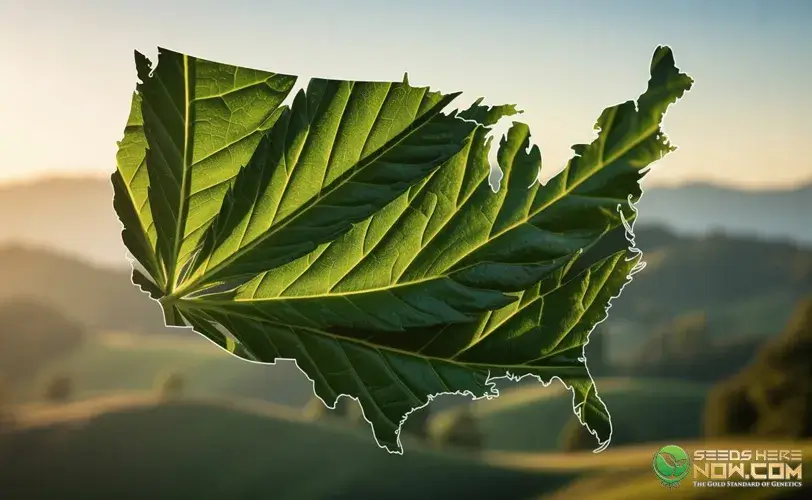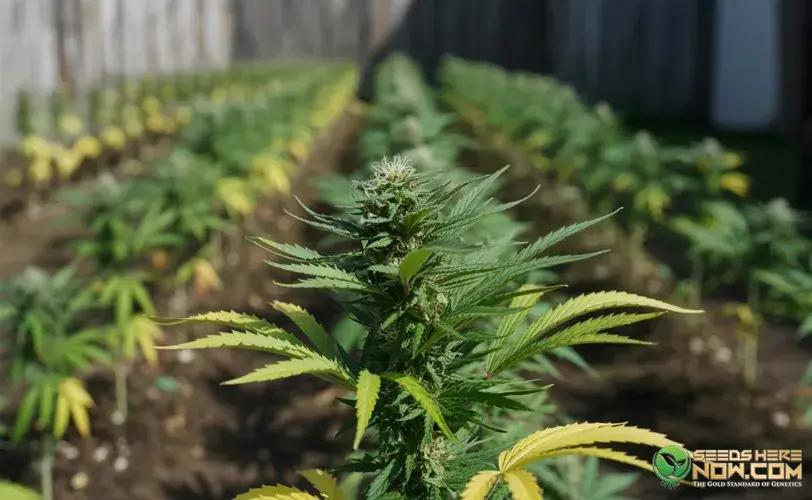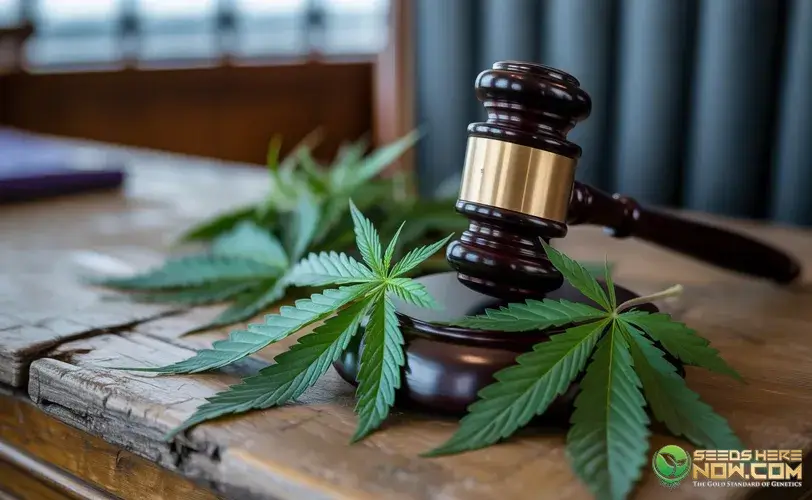Legal States Guide 2025: Where Cannabis Cultivation is Permitted

Alright, folks—settle in, grab your favorite (legally acquired, of course) thinking cap, because your old pal James Bean is here to navigate the wild, wacky, and wonderfully complex world of cannabis cultivation laws in the good ol’ U.S. of A for 2025!
As the head honcho at Seeds Here Now, I’ve seen it all, heard it all, and helped countless enthusiasts get their hands on the genetics that dreams are made of. But before you turn those dream seeds into reality, you’ve got to know the lay of the land. Trust me—an ounce of prevention (and legal knowledge) is worth way more than a pound of… well, you get the picture. Unpleasant conversations with folks in uniforms? No, thank you.
The cannabis legal landscape is shifting faster than a chameleon on a disco floor. What was a no-go yesterday might be A-OK today in your state—or vice versa. And then there’s the big green elephant in the room: Uncle Sam.
So, let’s dive into this guide, James Bean–style—a little wit, a lot of facts, and hopefully, enough guidance to keep your green thumbs on the right side of the law.
Uncle Sam’s Hazy Stance: The Federal Follies of 2025
The Schedule I Situation
As of early 2025, cannabis remains a Schedule I substance under the Controlled Substances Act. That means, according to Uncle Sam, it has a high potential for abuse and no accepted medical use. Yeah, I know—tell that to the millions finding relief and relaxation.
Rescheduling Buzz: Schedule III on the Horizon?
You’ve probably heard the chatter: The Department of Justice and the DEA proposed rescheduling cannabis to Schedule III after the Department of Health and Human Services weighed in, saying cannabis has medical uses and isn’t as “gnarly” as Schedule I drugs.
Public comment wrapped in July 2024, and a DEA hearing was scheduled for August. Some insiders predict a ruling in 2025; others whisper that the effort might stall indefinitely. It’s like waiting for your favorite strain to cure—patience, my friends.
What Rescheduling to Schedule III Would Actually Mean
Is It Federally Legal?
No. Rescheduling would not make recreational cannabis federally legal. Only FDA-approved cannabis-based medications would be allowed.
The Tax Man Cometh (Less Aggressively?)
IRS Code Section 280E—yes, that bane of cannabis businesses—would likely go away. That’s a big deal for financial viability.
Banking Bonanza?
Maybe. Schedule III might ease some banking restrictions, but the SAFE Banking Act is still needed for full reform.
Research Renaissance
With fewer regulatory hoops, research on cannabis would expand. Yes, please!
Interstate Commerce Dreams
Don’t hold your breath. Rescheduling alone won’t legalize cross-state sales.
Enforcement and Protections
Federal law still trumps state law. The DOJ can enforce federal bans in legal states. Remember the Cole Memo? It was scrapped in 2018. Though we do see soft guidance and occasional enforcement reminders, like DOJ letters to D.C. dispensaries near schools.
The Rohrabacher-Farr amendment (aka Joyce-Harris or Blumenauer) remains critical. This clause in federal spending bills blocks DOJ interference in state medical programs. Its renewal in the FY 2025 budget is crucial.
The Hemp-Derived Cannabinoid Chaos
That 2018 Farm Bill cracked open a can of worms. Now we’ve got Delta-8 and other intoxicating hemp-derived cannabinoids (IHDCs) in a legal gray zone. Regulation efforts are all over the place—and changing quickly.
The State-By-State Green Zone Breakdown: Your 2025 Cultivation Roadmap
Let’s break this down into four main categories.
Category 1: The “Grow Your Adventure” States
Recreational & Medical Home Cultivation Permitted
These states allow adults and patients to grow cannabis at home. Here’s the breakdown of where your green thumb can flourish in 2025.
Alaska
Up to six plants per person, with a max of three flowering. Two adults = 12 plants, only six flowering.
Arizona
Adults 21+ can grow up to six plants each, with a 12-plant household limit.
California
Six plants per residence for adults. Medical patients may grow more with a doctor’s note. Watch for local rules!
Colorado
Six plants per adult, three flowering. Household cap: 12. Local laws apply—Denver enforces a strict household limit.
Connecticut
Six plants per adult (three mature, three immature); 12-plant household cap for all users.
Maine
Three mature, 12 immature plants per adult. Seedlings are unlimited.
Maryland
Two plants per household. New cultivation licenses on deck for 2025.
Massachusetts
Six plants per person; 12-plant household limit. Medical hardship registration can increase limits.
Michigan
Twelve plants per household for adults 21+. One of the most generous laws on the books.
Minnesota
Eight plants per household (four mature). Commercial licensing opened in early 2025.
Missouri
Six flowering, six immature, and six clones for registered patients.
Montana
Two mature and two seedlings for rec. Four and four for medical patients.
Nevada
Six plants per person (12 per home), but only if no dispensary is within 25 miles.
New Mexico
Six plants per adult, with a 12-plant household cap.
New York
Three mature and three immature plants per person; six mature and six immature per household.
Ohio
Six plants per adult; 12 per household. Watch for possible legislative tweaks.
Oregon
Four plants per household. More allowed for medical users.
Rhode Island
Six plants (three mature) allowed per adult. Medical limits are higher.
Vermont
Two mature and four immature plants per person.
Virginia
Up to four plants per household allowed. Retail sales still on hold.
District of Columbia
Six plants (three mature) per adult; 12-plant household cap. Sales prohibited due to federal restrictions.
⚠️ Note for All Category 1 Growers
Plants must be out of public view, in a secure and enclosed space, and away from minors. Local laws may impose tighter limits.
Category 2: “Medical Card Green Thumb” States
Medical Home Cultivation Only
You’ll need a medical card to grow in these states.
Illinois
Five plants per registered patient.
Oklahoma
Six mature plants and six seedlings.
South Dakota
Three to four plants for qualified patients.
Hawaii
Up to 10 plants. Caregiver cultivation sunsets Jan. 1, 2025.
Washington
Up to six plants if registered; four if not. Recreational grow is still a felony.
Category 3: “Look, Don’t Touch (Your Soil)” States
Sales Permitted, but Home Grow Prohibited
These states say “no” to personal cultivation—for now.
Delaware, New Jersey, Florida, Arkansas, Kentucky, Louisiana, Mississippi, New Hampshire, North Dakota, Pennsylvania, Utah, West Virginia, Alabama
Category 4: “Still Waiting for the Green Light” States
Illegal or CBD-Only
Strict laws still dominate in:
Idaho, Kansas, Wyoming, Georgia, Indiana, Iowa, North Carolina, Tennessee, Texas, Wisconsin (Most have only limited CBD/low-THC programs)
Hot Tips From Your Pal James Bean: Cultivating Success (and Staying Legal)
Check Local Rules First—Always
State law is only part of the story. Local municipalities can ban or restrict home grow. Research zoning, odor, security, and permit rules on your city/county websites.
Compliance Is Key
For Home Growers
Lock It Up
Enclosed, locked grow space is typically required.
Keep It Private
No peeking plants in windows or yards.
Keep It Safe
Away from kids and pets.
For Commercial Cultivators
Licensing Is Brutal
Applications are competitive, expensive, and paperwork-heavy.
Security Standards
Think cameras, alarms, and perimeter fencing.
Seed-to-Sale Tracking
METRC or equivalent is mandatory.
Testing Rules
Expect potency and contaminant testing.
Taxes (280E)
Still a burden until rescheduling changes things.
What’s Sprouting Next? A Look Ahead to 2025 and Beyond
States on the Brink
Pennsylvania
Governor pushing hard for adult-use in 2025.
Florida
Another ballot measure coming in 2026.
Hawaii
Medical caregiver model shifting in 2025; adult-use discussions intensifying.
New Hampshire
Legislation stalled, but pressure’s rising.
Other Watchlist States
Louisiana, South Carolina, Kansas, North Carolina, Indiana, Kentucky, Mississippi, Tennessee, Texas
Trends To Watch
Social Equity
Focus continues on fair licensing and reinvestment.
Home Grow Debates
Still hot in places like Washington and New Jersey.
Delta-8 and IHDC Regulation
Expect new federal and state actions.
Tax Pressure
High rates risk pushing consumers back to the illicit market.
Wrapping It Up: Stay Smart, Stay Legal, Stay Growing
If there’s one thing to remember, it’s this: cannabis laws are complicated and constantly evolving. What’s legal in one place might be criminal in another.
Know your state. Know your city. Know your plant count. And if you’re going commercial, double down on compliance—because there’s no harvest if your crop gets seized.
And of course, if you’re growing legally, start with the best genetics around:
🌱 SeedsHereNow.com
🌱 SHNAuctions.com
🌱 IWantClones.com
Got questions? Drop them in the comments. Let’s grow together—legally, of course.
Peace,
James Bean
Suggested Articles
;)
;)
;)






 05 Oct 2025
05 Oct 2025  10 min read
10 min read


 July 24, 2025
July 24, 2025 


RESPONSES (0)
No responses yet. Be the first to respond!